Falling in love with the forest
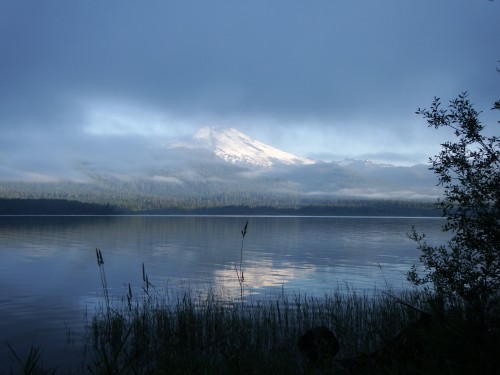
When I first learned that I would be leading a Youth Leadership Adventures course on Baker Lake, I was a bit…wary. Don’t get me wrong—I knew Baker Lake would be lovely. And although it is much easier to access than Ross Lake (where many of our courses happen), I knew the students would still feel like they were in the middle of the wilderness. But. I had heard stories from other instructors who had led trips at Baker Lake before. Stories of rowdy groups camped out in our reserved sites, unwilling to leave. Stories of so many motor boats on the lake that crossing the narrow span of the reservoir by canoe was…challenging. I knew that our group would be fine, that whatever happened, we would figure everything out. But as we departed from the Learning Center last week, there was still a corner of doubt in my mind.
Before we got to Baker Lake for the canoe-camping portion of our trip, however, we would be backpacking to Mazama Camp, 3.7 miles from the Schreiber’s Meadow trailhead. I had hiked up Railroad Grade before, which shares much of the trail en route to Mazama Camp. We had checked the map ahead of time, and it appeared that we gained 400 feet in elevation, and then descended back down those 400 feet to the camp. That seemed pretty reasonable, even for the group’s first time backpacking. Now, I will be the first to admit that my math skills are not my strongest asset (my students will attest that sometimes counting to 12 can be hard for me)…but the hike was three miles of up, and then .7 miles back down 400 feet. (I still need to look at that topo map again…) Regardless, our group did eventually make it there, after a good amount of snow travel, and were greeted with a scene of incomparable subalpine beauty.
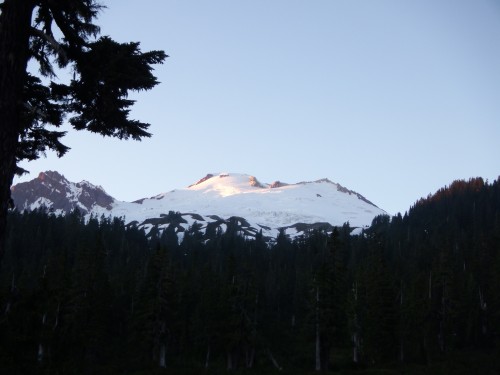 Mount Baker from Mazama Camp
Mount Baker from Mazama Camp
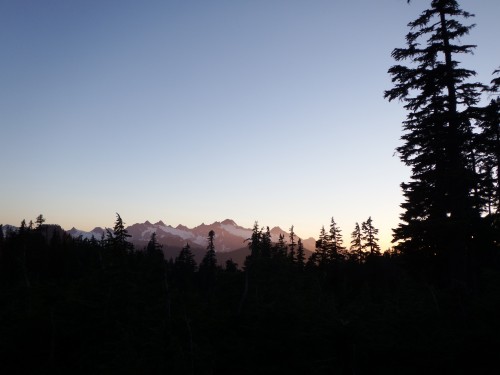 Mountains from Mazama Camp
Mountains from Mazama Camp
I have not done as much backpacking in the North Cascades as I have aspired to. But that said, this campsite is one of the most incredible I’ve gone to—especially considering the length of the approach. Mazama Camp is simply spectacular. Somehow it did not seem like our students were completely dumbfounded by the pristine splendor of the place we would be staying for the next two days, but us three instructors were awestruck. Perhaps the students were somewhat distracted by the spectacular physical experience of backpacking for the first time. Although they were all troopers, and enjoyed getting to do some butt-sledding down a snowbank, they were definitely tired out by the time we reached camp. However, they rallied for our day-hike the next day, up to the Park Butte Lookout, which kept watch above our camp. Although it is currently not an active lookout, it is maintained, and is open for visitors to write in the guest book or spend a night or two on the rickety bed.
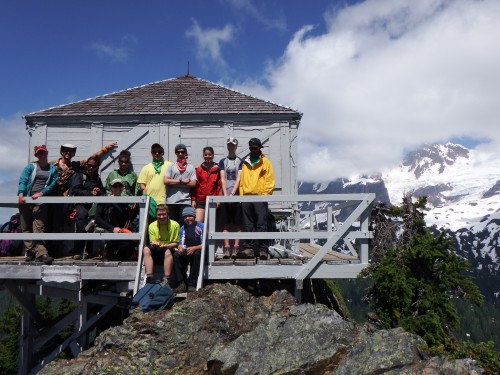 Our group in front of the Park Butte Lookout
Our group in front of the Park Butte Lookout
Glaciers are a topic covered in multiple North Cascades Institute curricula, and I have taught lessons on them and their life cycles many times. The night before our hike, we three instructors were giddily discussing all the different things we wanted to teach the next day. When we were crossing a snowfield, with Mount Baker looming behind us like a…well, like a giant snow-covered volcano, I hollered for the group to stop. I just could not pass up such a perfect teaching environment. I got to teach these students about how glaciers form, while standing on mid-summer snow, and staring at a glacier-covered mountain that holds the record for the most snowfall measured in the United States (1,140 inches, in the 1998-1999 winter season).
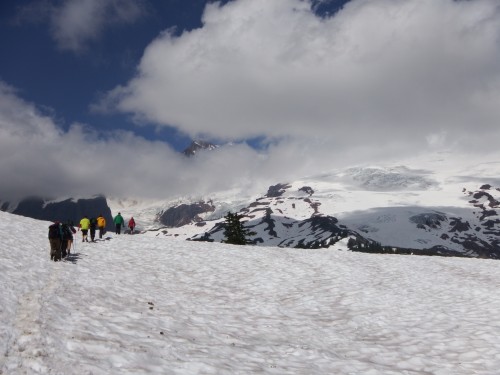 Students hiking on a snowfield below Mount Baker
Students hiking on a snowfield below Mount Baker
When I have taught a lesson like this with the Institute’s Mountain School program in the past, I have had the students build mountains with sand and gravel on the beach, and then use pre-made “glaciers” to scrape moraines (ridges created by glacial movement) into their mountains. Although this is perhaps more accurate, I decided reversing it made more sense in our situation. After mimicking the birth of a glacier by making iceballs, I had the students make snow-mountains, and then carve moraines into them using rocks. The icing on the cake (puns always intended) was that directly across from us were the massive Railroad Grade and Metcalfe Moraines left by the Easton Glacier, created by many generations of glaciers pushing rock, dirt, and anything else in their paths out of the way. Getting the opportunity to teach such a place-based lesson always gives me a rush as an educator, and I enjoyed getting to teach the students about these powerful natural forces as much as they enjoyed pelting each other with their iceballs after the lesson was over.
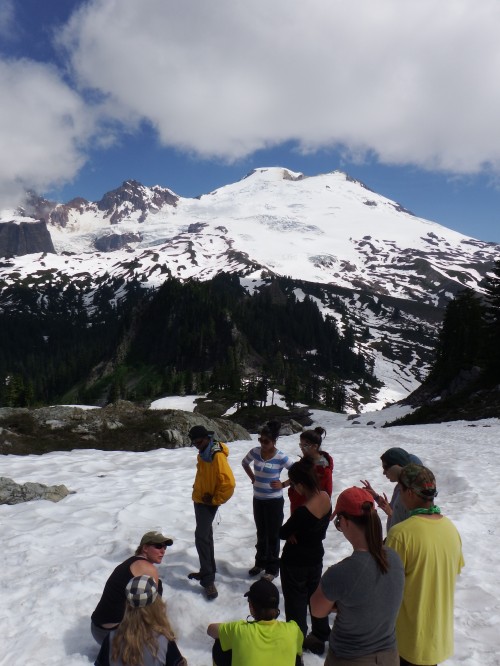 The author teaching a glacier lesson below Mount Baker. Note the dark angled bands of rock in the right side of the photo, Railroad Grade and Metcalfe Moraines.
The author teaching a glacier lesson below Mount Baker. Note the dark angled bands of rock in the right side of the photo, Railroad Grade and Metcalfe Moraines.
After two days filled with sun, snow, and mountains, while being serenaded by pikas, marmots, and hummingbirds, it was time to descend to Baker Lake. Most of the students were excited—to try out canoeing, because our hike was mostly downhill, and because it would be warmer than forty degrees at night. We were first transported to the Horseshoe Cove boat launch, a major hub of activity on the lake. I hoped it was not a premonition of things to come out on the water. We set off from the east side of the lake and I quickly breathed a sigh. Behind us, Mount Baker came into view again, a comforting anchor in the landscape.
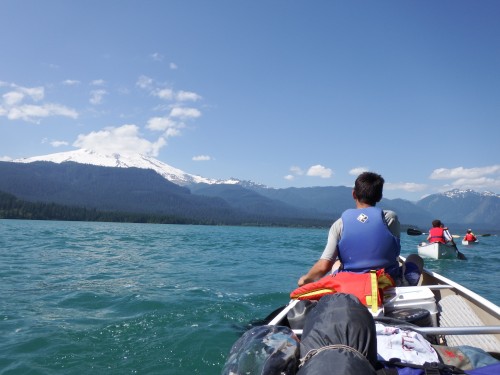 Students canoe to our first campsite on the lake, with Mount Baker to our left.
Students canoe to our first campsite on the lake, with Mount Baker to our left.
When I have led trips on Ross Lake, I never worry about finding my way, because I know the chain of campsites along the lake so well. Before departing on this trip, I had grilled veteran Institute instructor and previous Baker Lake course leader, Kevin Biggs, about how to find our first camp, Maple Grove. His description: “It’s a big alluvial fan covered with light green deciduous trees. You won’t be able to miss it.” I figured that would still be possible, but as soon as we rounded the first corner from the cove, I saw it. He was right. It was impossible to miss. And what’s more, I learned after we arrived that it is a magical, beautiful camp, dappled with golden green light that a camera simply cannot do justice.
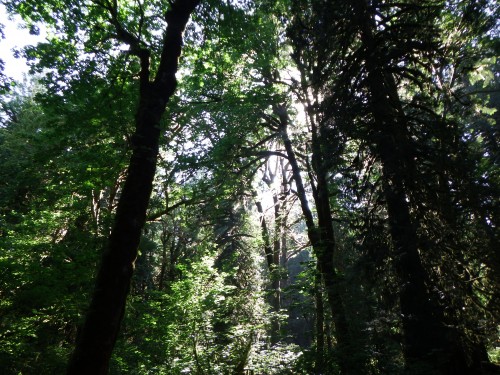 Moss-covered Bigleaf maple trees at Maple Grove camp.
Moss-covered Bigleaf maple trees at Maple Grove camp.
Before I had that latter revelation, however, we encountered two groups attempting to camp at Maple Grove (which had been temporarily closed by the Forest Service for us to carry out service projects at the site). Two Forest Service employees happened to be there when we arrived, and had explained the closure to the groups, although they told us that ultimately our group had the power to say stay or go. One group, a family with a large boat (and a full-size Rubbermaid trash can) had already decided to move on, which left a pair of backpackers and their dog. We figured this decision would be a good one for our student “Leader of the Day” to make. She first scoped out the campsite, and after seeing there was plenty of space for the group to stay (and knowing first-hand how hard backpacking is), she decided to let them stay the night.
Although I will admit that the super-charged-turbo-hydraulic-spaceship fishing boats that cruised the lake around 4am did make me a little disgruntled in the wee hours, I feel so lucky that I got to lead this course in the Mount Baker-Snoqualmie National Forest. At least while we were there the lake was no busier than Ross Lake, in my experience. At Maple Grove, our group got to install four bear boxes to help make sure the local bears (and chipmunks, squirrels, mice, etc.) stay wild, healthy, and safe. Although challenging at times, this project was a rewarding and very tangible way for our students to give back to the beautiful place they spent a week in.
Our group came together as a community, going from strangers to close friends in just a few days. The students, some originally from places as far away as Nepal and Jordan, learned about wilderness, what stewardship means, and how to hang a bear hang. As for me, I also learned many lessons along the way—including that Baker Lake (and the rest of the Mount Baker-Snoqualmie National Forest) is an amazing place to get to spend a week helping students fall in love with the North Cascades.
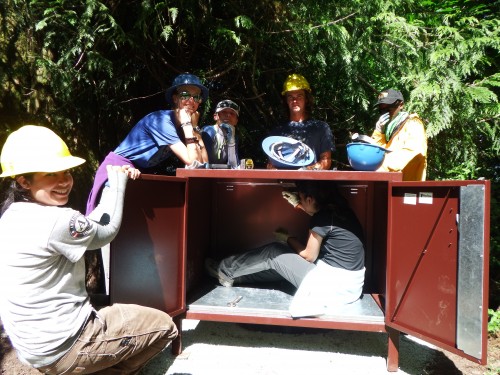 Students and Forest Service staff pose with a bear box that they are almost finished installing.
Students and Forest Service staff pose with a bear box that they are almost finished installing.
Leading photo: Mount Baker says good morning. All photos taken by the author and co-instructors Guy Whol and Hillary Schwirtlich
Kate Rinder is an alumni of the graduate program offered in partnership by North Cascades Institute and Western Washington University. This is the third summer she has led courses for the Institute in the incredible landscape of the North Cascades. When not laughing and learning with teenagers in the field, Kate spends her time rock climbing, doing yoga, and trying to find things to eat in the woods.


Thanks for sharing.
Jerry
Awesome tale Kate. I wanna go to those places too this summer! Thanks for taking these students out and helping to change their lives — they’ll never forget the week they spent with you!
What a beautiful place and wonderful story. Thanks Kate, for inspiring these students with your passion.
Great story Kate. I basically grew up at Baker Lake and love it to this day and still spend a lot of time there. When I was young the lake didn’t have “recreational boaters.” The only real visitors to the lake were die hard fishers and campers. While it was a good deal more peaceful and unpopulated back then, it remains a jewel of our area with astounding unspoiled beauty. Glad you were able to introduce so many young folks to the wilderness in the area!
Man. I remember this like it was yesterday. Went looking for pictures of the Park Butte lookout to show a friend who plans on visiting. I wanted to take them up there and this came up. I’m that kid in the neon yellow shirt sitting down on the stairs at the lookout. This was an amazing adventure, and I’m glad I was able to have the opportunity to do this. 10/10 would do it again!